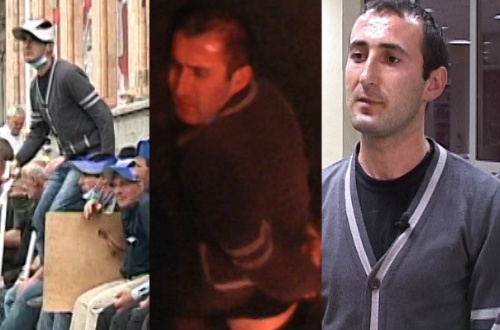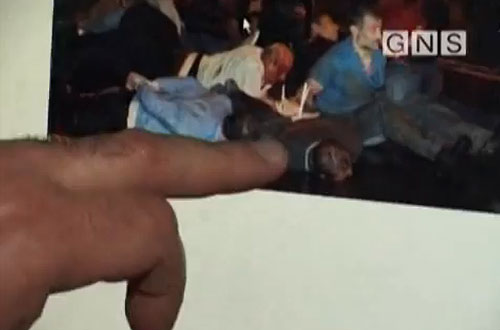| Report Questions Protester's Electrocution Death Version |
| Civil Georgia, Tbilisi / 6 Sep.'11 / 16:40 |

This compilation of three photos was released by the Interior Ministry after GYLA-commissioned report by the UK forensic firm said a photo from the protest scene (in middle) showed Nika Kvintradze, who according to official version died of electrocution. The Interior Ministry, however, said the photo (in middle) depicts Giorgi Bakradze, another protester, also seen on the photos on the left and right.
A facial comparison and image analysis, commissioned by Tbilisi-based legal advocacy group Georgian Young Lawyers Association (GYLA) and carried out by the UK forensic firm, DABS Forensic Ltd, suggest that a protester, who police claim died of electrocution, was among those arrested by the riot police after breaking up of the anti-government rally shortly after midnight on May 26.
Hours after the break up of the rally, the Interior Ministry said on May 26, that a policeman and a protester died after a car crash when a motorcade, taking several protest leaders, including Nino Burjanadze, away from the protest scene, drove into the crowd.
On May 27, according to the Interior Ministry, bodies of two other protesters - Nika Kvintradze and Suliko Asatiani – were found on a roof of one of the shops just next to the protest venue. The Interior Ministry said that a forensic expertise had confirmed these two deaths were caused by electrocution.
This official version was questioned few days later after a friend of Nika Kvintradze, Rezo Rekhviashvili, claimed that Kvintradze was arrested by the police during the dispersal of the rally and he had no chance to escape and to appear on a roof of a nearby shop; Rekhviashvili told the Report of the Week program aired by the Maestro TV on May 29 that he identified his friend on a photo from the protest scene, saying that the handcuffed man on the photo, laying face-down on the ground is Nika Kvintradze.
In an apparent attempt to disavow this allegation, Rustavi 2 TV aired a day-time footage showing Nika Kvintradze and his friend standing at a rally outside the Parliament. Rustavi 2 said the footage was shot on May 25 with Kvintradze wearing a shirt different from the one the man on the photo.
The Georgian Young Lawyers Association (GYLA) said on September 6, that in an attempt to have “unbiased” examination of available evidence, it had commissioned an expertise to the UK-based forensic firm DABS Forensic Ltd, which, GYLA said, was recommended by its partner organization British Association for Human Identification (BAHI).
Twelve images and video footage were sent in August to DABS Forensic Ltd, including post-mortem and passport photos of Kvintradze, as well as photos and footage from the protest scene on which the man seen handcuffed is claimed by Rekhviashvili to be Kvintradze.
“If one important difference is found it could preclude the possibility that the images are of the same person,” writes Kenneth Linge, a forensic facial mapping and image comparison consultant, in his report, released by GYLA on September 6.
According to the report while “no important differences” were found, seven “apparent similarities”, including face shape, hairline, supraorbital ridge, nose type and others were identified.
“As no important differences could be found and because of the number of apparent similarities that were found my opinion is that the images lend strong support to the contention that all three images, that is the passport image [of Kvintradze], image #4 [from the protest scene] and the post-mortem photograph [of Kvintradze] are all of the same person,” Linge writes.
Tamar Chugoshvili, a chairperson of GYLA, said on September 6, that findings of the report “clearly show” that Kvintradze was arrested before he died. She also said that the findings “cast serious doubts over the official version of the circumstances of Nika Kvintradze’s death.”
She also said that GYLA would send the findings to the chief prosecutor’s office for further investigation of the case. GYLA said it had spent UK£ 1,500 from its funds for commissioning of the expertise.

A screengrab from the Report of the Week TV program, produced by studio GNS and aired by Maestro TV on May 29 in which a man points finger on an arrested protester, claiming that he is his friend Nika Kvintradze, who the police say died of electrocution on a roof of a shop close to the protest venue.
The Interior Ministry, however, immediately dismissed the finding of the report, insisting that Kvintradze died of electrocution and that the man seen on the photo from the protest scene was in fact Giorgi Bakradze, a resident of Kareli district. Few hours after GYLA released the report, the Interior Ministry responded by disseminating footage of Giorgi Bakradze; this young man says in the footage that he was arrested by the police during the May 26 dispersal of the protest and released later on.
Shota Utiashvili, head of the analytical and information department at the Interior Ministry, said: “We are astonished with this statement by this organization”, referring to GYLA. He said that the man seen on the photo from the protest scene “is alive and in good health.”
Meanwhile, the opposition Republican Party released a statement on September 6, saying that the finding of GYLA-commissioned report showed, that Kvintradze died after being arrested by the police. The party also said there “is a high probability” that the law enforcement agencies were in “orchestrated efforts to cover-up the crime.”
“In this situation, the President of Georgia has to make a choice: to either use all the available for him means to secure a prompt, objective and comprehensive investigation of the case or to become part of a cover-up of this terrible crime,” the Republican Party said in the statement.
